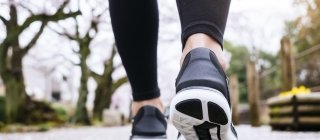Join Us for National Walk@Lunch Day

Discover the countless benefits of walking, from improving heart health to relieving joint pain and managing stress. Plus, find tips on how to make walking a regular part of your routine.
Walking just 30 minutes a day can improve both your physical and mental health. Taking a brisk daily walk can lower your blood pressure, reduce risk of heart disease, help control stress, and improve your mood.
A great way to begin a daily walking habit is to participate in National Walk@Lunch Day, held on the last Wednesday of April. This year, National Walk@Lunch Day falls on April 30. Blue Cross Vermont employees will participate by taking a group walk along roads near our Berlin headquarters. Remote employees will also participate by walking near where they live.
You can join us on National Walk@Lunch Day by getting outside to walk wherever you are. During your lunchtime walk you’ll enjoy fresh air, the sights and sounds of spring, and hopefully some sunshine. You’ll also be giving your health a boost.
More Walking Benefits
Taking a daily walk produces many health benefits, including:
- Improve heart health. Studies have found that people who walk daily have a 30 percent lower risk of having a heart attack or stroke.
- Reduce risk of type 2 diabetes. Walking at a brisk pace produces a 24 percent lower risk of type 2 diabetes, according to several studies. Even a leisurely stroll cuts type 2 diabetes risk by 15 percent.
- Manage stress. Going for a walk in a natural environment, such as a forest, decreases activity in stress-related parts of the brain, a study found.
- Improve sleep. Walking for at least 2,000 steps (about a mile) daily improved sleep quality and duration among participants in a study.
- Increase brain function. People who walked more than 4,000 steps a day had better cognitive functioning than those who walked less than 4,000 steps a day, a study found. Moderately-paced walks have also been shown to stimulate brain-derived neurotrophic factor, a protein that promotes growth of neurons in the brain.
- Relieve joint pain. Walking is a low-impact exercise that helps strengthen muscles, which takes pressure off joints. A study found that people who walked for exercise were less likely to develop knee pain.
- Prevent bone loss. Researchers found that walking is effective in slowing the rate of bone loss from the legs. Women who walked more than 7.5 miles a week had higher bone density than women who walked less than a mile per week, a study showed.
The bottom line: it’s well documented that walking regularly can keep you healthier and improve the quality of your life.
Finding Places to Walk
In Vermont, we’re fortunate to have thousands of miles of scenic dirt roads to walk on. Remember to walk on the left side of the road so that you’ll be able to see oncoming traffic. Stay on the shoulder of the road as much as possible. To ensure drivers can see you, wear light-colored clothing. Adding reflective material will help improve your visibility and safety, especially when walking early in the morning or in the evening.
If you’d rather walk someplace that’s separate from vehicle traffic, many communities have bike paths and walking trails you can use. To find trails near you, check out:
- TrailLink has a list of 39 multi-use recreational trails around Vermont.
- Trail Finder has information on hundreds of trails in Vermont and New Hampshire. On the right side of the page, select walking in the trail activity drop down menu. You can also filter walking trails by location to find ones within a certain distance of your town.
- Vermont’s Rail Trail System which covers more than 148 miles.
Walking Tips
Going for a walk seems simple — just put one foot in front of the other. But getting into the habit of walking daily and sticking with it is more complex. Here are some tips to help you adopt a walking routine.
- Start slowly. At first, walk at a steady pace for five or 10 minutes. Then gradually increase the time you walk to at least 30 minutes a day. Also try to increase the distance you walk to more than a mile per day. One way to do this is to set a realistic goal, such as walking for 20 minutes. Once you’ve accomplished that, set another goal to keep challenging yourself.
- Plan several routes for variety. Walking the same route every day can be boring, so mix it up by alternating between several different routes. If possible, try to choose routes with a variety of terrain (some hills and some level sections).
- Invite others to join. Walking with family and friends helps keep it interesting and fun. If no other people are available, take your pet(s) for a walk. They’ll enjoy the exercise and you’ll like the companionship.
- Keep it consistent. The easiest way to make walking a habit is to do it consistently as part of your daily routine. For example, going for a walk during your lunch break. If something comes up and you can’t walk at your regular time, schedule time later in the day to get the walk in.
- Have a bad weather backup plan. If stormy weather prevents you from getting outside for your daily walk, have an alternative method of getting your steps in. That may include walking the corridors at a local shopping mall or going to a gym to use a treadmill.
- Stay hydrated. Be sure to bring water with you, especially during the warmer months. You’ll be more comfortable and walk farther when you’re well hydrated.
- Bring something to listen to. Some people enjoy quiet during their walks, while others prefer listening to audiobooks or music. You can make a playlist that alternates slower-paced songs with faster ones to give you different tempos to walk to.
- Track your progress. There are many smartphone apps you can use to track your walks. Or use a wearable fitness tracker like a Fitbit to monitor data like distance walked, heart rate, and calories burned.
Share Your Walking Photos
We hope this article has inspired you to get outside for a walk — not only on National Walk@Lunch Day, but every day of the year. We’d love to see some photos of you and your friends on your walks! You can share them with us by posting on social media with the tag @BlueCrossVT.



